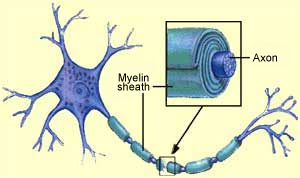Electrical conduction lets
nerve impulses travel rapidly within a neuron.
It involves a brief electrical
fluctuation that propagates down the neuron’s dendrites,
then through its cell body and out to the tip of its axon.
Electrical conduction is what
gives the nervous system the rapid-response capability
that is lacking in the body’s
other major means of communication, the hormonal system. |
 |
Chemical transmission takes
place in the synapses between neurons, enabling nerve impulses
to be transmitted from one neuron to the next.
This process is called “chemical transmission” because
the diffusion of chemical molecules from one neuron to the
next is what enables the electrical impulse to be reconstituted
in that second neuron.
Chemical transmission gives the brain the flexibility that
is required for learning. |






